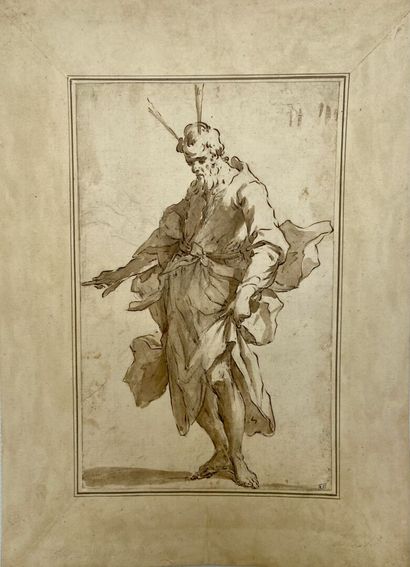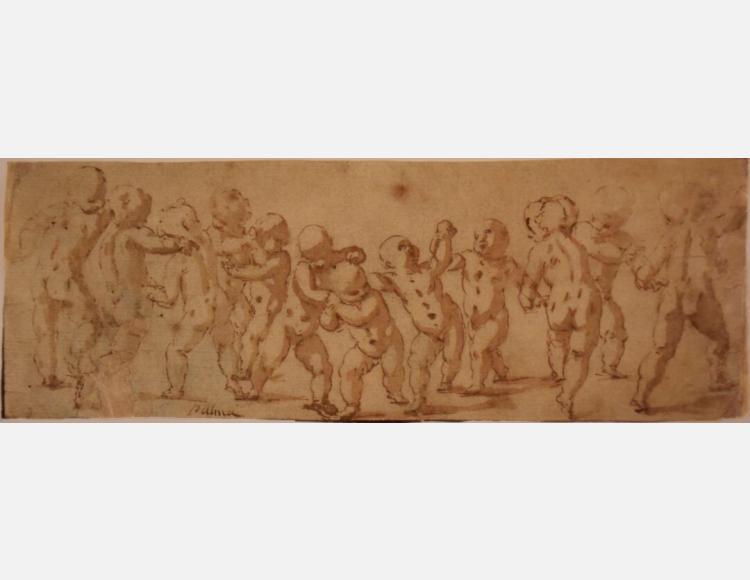Details
JACOPO DI ANTONIO NEGRETTI DIT PALMA LE JEUNE (VENISE 1544-1628)
Saint Jean Baptiste
signé et localisé 'JACOBVS PALMA / VENETVS / .F.' (au centre, à droite, sur le rocher)
inscrit '183' (en bas, à gauche)
huile sur toile
205,5 x 117 cm. (80 3/4 x 46 1/8 in.)
Provenance
Diego Mexía Felípez de Guzmán y Dávila (1580-1655), Marqués de Leganés, Palacio de San Bernardo, Madrid, en 1637, n°183 ; puis par descendance à Ventura Osorio de Moscoso y Guzmán (1707-1734), Conde de Altamira, Palacio de San Bernardo, Madrid, en 1726, n°183.
Colnaghi, Londres.
Collection particulière, Espagne.
Literature
J. López Navío, 'La gran colección de pinturas del Marqués de Leganés', Analecta Calasanctiana, 1962, 4e année, VII, p. 277, n°183.
J. J. Pérez Preciado, El Marqués de Leganés y las artes, thèse de doctorat, Université de Madrid, 2010, II, pp. 147-148, n°183.
Special notice
This item will be transferred to an offsite warehouse after the sale. Please refer to department for information about storage charges and collection
details.
Post lot text
JACOPO DI ANTONIO NEGRETTI CALLED PALMA IL GIOVANE, SAINT JOHN THE BAPTIST, SIGNED AND LOCATED, INSCRIBED, OIL ON CANVAS
This monumental painting stands as testament to the powerful style of the Venetian painter Palma il Giovane (1544-1628). The great-nephew of Palma il Vecchio (1480-1528) and son of the painter Antonio Negretti (1515-1575), the artist first studied the works of Raphael (1483-1520) and Titian (1488-1576) before spending nine years in Rome, where he benefited from the influence of the paintings of Michelangelo (1475-1564) and the Roman Mannerist circle. On his return to Venice in 1569, he collaborated with Tintoretto (1518-1594) on various projects including the restoration of the Doge's Palace after the great fire of 1574.
It is the subtle combination of these diverse influences that makes Saint John the Baptist such a successful composition. The muscular body with its sinuous lines retains the vigour of the Mannerist models, but the whole is impregnated with the rich, dark colours and the robust application of wonderfully thick paint so typical of the Serenissima. This eclecticism made Palma il Giovane one of the most outstanding Venetian painters of the second half of the sixteenth century, and one of the most sought-after by the great European patrons of his day.
The inclusion of the term "Venetus" in the present signature indicates that our painting was intended for a collection outside Italy, where the artist's origins would not have been known. The number in the lower left-hand corner of the painting has allowed us to discover the identity of the original owner, namely Diego Mexía Felípez de Guzmán y Dávila, Marqués de Leganés (1580-1655), one of the greatest collectors of the early seventeenth century. From 1600 he was in the service of Albert VII (1559-1621) in the Spanish Netherlands. Here he met Peter Paul Rubens (1577-1640), who described him in a letter dated 27 January 1628 to the scholar Peter Dupuy (1582-1651) as "one of the most important connoisseurs of our time" (see R. Magurn, The Letters of Peter Paul Rubens, Cambridge, 1955, no. 145). The Marquis' authority grew during the first decade of Philip IV's (1605-1665) reign, thanks to his friendship with Gaspar de Guzmán (1587-1645), Count of Olivares, a favourite of the king. It was during this period that he began collecting paintings in earnest – an inventory of his possessions in 1630 numbers seventeen paintings – from here his collection grew exponentially; the 1637 inventory comprises seven hundred and fifty paintings, including Saint John the Baptist. Works from the Leganés collection are currently housed in the world's most important museums, including the Prado in Madrid, the Rubenshuis in Antwerp, the Royal Museums of Fine Arts in Brussels and the Museum of Fine Arts in Houston.
The subject of St John the Baptist in the desert appears repeatedly in the history of Western art. It has its origins in the Old Testament, where the prophet Isaiah foretells the “Voice of one crying in the wilderness" (Isaiah, 40, 3). These words are repeated in the four Gospels, which specify that St John is the one whose advent was been announced. This idea of the desert, of a wilderness with all its Romantic possibilities, inspired artists throughout the ages. We find examples in the work of Hans Memling (1430-1494) and Hieronymus Bosch (died 1516) in the fifteenth century, in that of Raphael and Titian in the first half of the sixteenth century, in the work of Murillo (1617-1682) in the seventeenth century, and even a Young St. John the Baptist in the desert by the English painter Sir Joshua Reynolds (1723-1792) at the end of the eighteenth century.
As in the present painting, these images all share the motif of the lamb, the symbol of Christ, accompanying the Baptist, and for the most part also include a stream of water; both refer to St John's words, "I baptize you with water for repentance. But after me comes one who is more powerful than I, whose sandals I am not worthy to carry. He will baptize you with the Holy Spirit and fire" (Matthew, 40, 11). Palma painted several versions of the subject during his career, one of which, dating from 1602, is in the Church of St John the Baptist in Bagno, one in the Khanenko Museum in Kiev, and one in the Cantor Arts Centre in Stanford, California (inv. no. 66.73).
Details
JACOPO DI ANTONIO NEGRETTI DIT PALMA LE JEUNE (VENISE 1544-1628)
Saint Jean Baptiste
signé et localisé 'JACOBVS PALMA / VENETVS / .F.' (au centre, à droite, sur le rocher)
inscrit '183' (en bas, à gauche)
huile sur toile
205,5 x 117 cm. (80 3/4 x 46 1/8 in.)
Provenance
Diego Mexía Felípez de Guzmán y Dávila (1580-1655), Marqués de Leganés, Palacio de San Bernardo, Madrid, en 1637, n°183 ; puis par descendance à Ventura Osorio de Moscoso y Guzmán (1707-1734), Conde de Altamira, Palacio de San Bernardo, Madrid, en 1726, n°183.
Colnaghi, Londres.
Collection particulière, Espagne.
Literature
J. López Navío, 'La gran colección de pinturas del Marqués de Leganés', Analecta Calasanctiana, 1962, 4e année, VII, p. 277, n°183.
J. J. Pérez Preciado, El Marqués de Leganés y las artes, thèse de doctorat, Université de Madrid, 2010, II, pp. 147-148, n°183.
Special notice
This item will be transferred to an offsite warehouse after the sale. Please refer to department for information about storage charges and collection
details.
Post lot text
JACOPO DI ANTONIO NEGRETTI CALLED PALMA IL GIOVANE, SAINT JOHN THE BAPTIST, SIGNED AND LOCATED, INSCRIBED, OIL ON CANVAS
This monumental painting stands as testament to the powerful style of the Venetian painter Palma il Giovane (1544-1628). The great-nephew of Palma il Vecchio (1480-1528) and son of the painter Antonio Negretti (1515-1575), the artist first studied the works of Raphael (1483-1520) and Titian (1488-1576) before spending nine years in Rome, where he benefited from the influence of the paintings of Michelangelo (1475-1564) and the Roman Mannerist circle. On his return to Venice in 1569, he collaborated with Tintoretto (1518-1594) on various projects including the restoration of the Doge's Palace after the great fire of 1574.
It is the subtle combination of these diverse influences that makes Saint John the Baptist such a successful composition. The muscular body with its sinuous lines retains the vigour of the Mannerist models, but the whole is impregnated with the rich, dark colours and the robust application of wonderfully thick paint so typical of the Serenissima. This eclecticism made Palma il Giovane one of the most outstanding Venetian painters of the second half of the sixteenth century, and one of the most sought-after by the great European patrons of his day.
The inclusion of the term "Venetus" in the present signature indicates that our painting was intended for a collection outside Italy, where the artist's origins would not have been known. The number in the lower left-hand corner of the painting has allowed us to discover the identity of the original owner, namely Diego Mexía Felípez de Guzmán y Dávila, Marqués de Leganés (1580-1655), one of the greatest collectors of the early seventeenth century. From 1600 he was in the service of Albert VII (1559-1621) in the Spanish Netherlands. Here he met Peter Paul Rubens (1577-1640), who described him in a letter dated 27 January 1628 to the scholar Peter Dupuy (1582-1651) as "one of the most important connoisseurs of our time" (see R. Magurn, The Letters of Peter Paul Rubens, Cambridge, 1955, no. 145). The Marquis' authority grew during the first decade of Philip IV's (1605-1665) reign, thanks to his friendship with Gaspar de Guzmán (1587-1645), Count of Olivares, a favourite of the king. It was during this period that he began collecting paintings in earnest – an inventory of his possessions in 1630 numbers seventeen paintings – from here his collection grew exponentially; the 1637 inventory comprises seven hundred and fifty paintings, including Saint John the Baptist. Works from the Leganés collection are currently housed in the world's most important museums, including the Prado in Madrid, the Rubenshuis in Antwerp, the Royal Museums of Fine Arts in Brussels and the Museum of Fine Arts in Houston.
The subject of St John the Baptist in the desert appears repeatedly in the history of Western art. It has its origins in the Old Testament, where the prophet Isaiah foretells the “Voice of one crying in the wilderness" (Isaiah, 40, 3). These words are repeated in the four Gospels, which specify that St John is the one whose advent was been announced. This idea of the desert, of a wilderness with all its Romantic possibilities, inspired artists throughout the ages. We find examples in the work of Hans Memling (1430-1494) and Hieronymus Bosch (died 1516) in the fifteenth century, in that of Raphael and Titian in the first half of the sixteenth century, in the work of Murillo (1617-1682) in the seventeenth century, and even a Young St. John the Baptist in the desert by the English painter Sir Joshua Reynolds (1723-1792) at the end of the eighteenth century.
As in the present painting, these images all share the motif of the lamb, the symbol of Christ, accompanying the Baptist, and for the most part also include a stream of water; both refer to St John's words, "I baptize you with water for repentance. But after me comes one who is more powerful than I, whose sandals I am not worthy to carry. He will baptize you with the Holy Spirit and fire" (Matthew, 40, 11). Palma painted several versions of the subject during his career, one of which, dating from 1602, is in the Church of St John the Baptist in Bagno, one in the Khanenko Museum in Kiev, and one in the Cantor Arts Centre in Stanford, California (inv. no. 66.73).












Try LotSearch and its premium features for 7 days - without any costs!
Be notified automatically about new items in upcoming auctions.
Create an alert